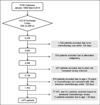Outcome of pediatric acute myeloid leukemia patients receiving intensive care in the United States
- PMID: 24366507
- PMCID: PMC4407366
- DOI: 10.1097/PCC.0000000000000042
Outcome of pediatric acute myeloid leukemia patients receiving intensive care in the United States
Abstract
Objective: Children with acute myeloid leukemia are at risk for sepsis and organ failure. Outcomes associated with intensive care support have not been studied in a large pediatric acute myeloid leukemia population. Our objective was to determine hospital mortality of pediatric acute myeloid leukemia patients requiring intensive care.
Design: Retrospective cohort study of children hospitalized between 1999 and 2010. Use of intensive care was defined by utilization of specific procedures and resources. The primary endpoint was hospital mortality.
Setting: Forty-three children's hospitals contributing data to the Pediatric Health Information System database.
Patients: Patients who are newly diagnosed with acute myeloid leukemia and who are 28 days through 18 years old (n = 1,673) hospitalized any time from initial diagnosis through 9 months following diagnosis or until stem cell transplant. A reference cohort of all nononcology pediatric admissions using the same intensive care resources in the same time period (n = 242,192 admissions) was also studied.
Interventions: None.
Measurements and main results: One-third of pediatric patients with acute myeloid leukemia (553 of 1,673) required intensive care during a hospitalization within 9 months of diagnosis. Among intensive care admissions, mortality was higher in the acute myeloid leukemia cohort compared with the nononcology cohort (18.6% vs 6.5%; odds ratio, 3.23; 95% CI, 2.64-3.94). However, when sepsis was present, mortality was not significantly different between cohorts (21.9% vs 19.5%; odds ratio, 1.17; 95% CI, 0.89-1.53). Mortality was consistently higher for each type of organ failure in the acute myeloid leukemia cohort versus the nononcology cohort; however, mortality did not exceed 40% unless there were four or more organ failures in the admission. Mortality for admissions requiring intensive care decreased over time for both cohorts (23.7% in 1999-2003 vs 16.4% in 2004-2010 in the acute myeloid leukemia cohort, p = 0.0367; and 7.5% in 1999-2003 vs 6.5% in 2004-2010 in the nononcology cohort, p < 0.0001).
Conclusions: Pediatric patients with acute myeloid leukemia frequently required intensive care resources, with mortality rates substantially lower than previously reported. Mortality also decreased over the time studied. Pediatric acute myeloid leukemia patients with sepsis who required intensive care had a mortality comparable to children without oncologic diagnoses; however, overall mortality and mortality for each category of organ failure studied was higher for the acute myeloid leukemia cohort compared with the nononcology cohort.
Figures

Similar articles
-
Association of weekend admission with hospital length of stay, time to chemotherapy, and risk for respiratory failure in pediatric patients with newly diagnosed leukemia at freestanding US children's hospitals.JAMA Pediatr. 2014 Oct;168(10):925-31. doi: 10.1001/jamapediatrics.2014.1023. JAMA Pediatr. 2014. PMID: 25155012 Free PMC article.
-
Hospital Variation in Intensive Care Resource Utilization and Mortality in Newly Diagnosed Pediatric Leukemia.Pediatr Crit Care Med. 2018 Jun;19(6):e312-e320. doi: 10.1097/PCC.0000000000001525. Pediatr Crit Care Med. 2018. PMID: 29528977 Free PMC article.
-
Clinical course of sepsis in children with acute leukemia admitted to the pediatric intensive care unit.Pediatr Crit Care Med. 2011 Nov;12(6):649-54. doi: 10.1097/PCC.0b013e31821927f1. Pediatr Crit Care Med. 2011. PMID: 21478790
-
Mortality rates in pediatric septic shock with and without multiple organ system failure.Pediatr Crit Care Med. 2003 Jul;4(3):333-7. doi: 10.1097/01.PCC.0000074266.10576.9B. Pediatr Crit Care Med. 2003. PMID: 12831416
-
Acute myeloid leukemia: does sex matter?Leukemia. 2024 Nov;38(11):2329-2331. doi: 10.1038/s41375-024-02435-z. Epub 2024 Oct 14. Leukemia. 2024. PMID: 39402216 Free PMC article. Review. No abstract available.
Cited by
-
Outcomes for paediatric acute leukaemia patients admitted to the paediatric intensive care unit.Eur J Pediatr. 2022 Mar;181(3):1037-1045. doi: 10.1007/s00431-021-04292-9. Epub 2021 Oct 25. Eur J Pediatr. 2022. PMID: 34694507
-
Risk of Mortality in Immunocompromised Children With Severe Sepsis and Septic Shock.Crit Care Med. 2020 Jul;48(7):1026-1033. doi: 10.1097/CCM.0000000000004329. Crit Care Med. 2020. PMID: 32301846 Free PMC article.
-
A comparison of resource utilization following chemotherapy for acute myeloid leukemia in children discharged versus children that remain hospitalized during neutropenia.Cancer Med. 2015 Sep;4(9):1356-64. doi: 10.1002/cam4.481. Epub 2015 Jun 24. Cancer Med. 2015. PMID: 26105201 Free PMC article.
-
The Flipside of the Power of Engineered T Cells: Observed and Potential Toxicities of Genetically Modified T Cells as Therapy.Mol Ther. 2017 Feb 1;25(2):314-320. doi: 10.1016/j.ymthe.2016.11.011. Mol Ther. 2017. PMID: 28153085 Free PMC article. Review.
-
Merging Children's Oncology Group Data with an External Administrative Database Using Indirect Patient Identifiers: A Report from the Children's Oncology Group.PLoS One. 2015 Nov 25;10(11):e0143480. doi: 10.1371/journal.pone.0143480. eCollection 2015. PLoS One. 2015. PMID: 26606521 Free PMC article.
References
-
- Creutzig U, Zimmermann M, Reinhardt D, et al. Early deaths and treatment-related mortality in children undergoing therapy for acute myeloid leukemia: Analysis of the multicenter clinical trials AML-BFM 93 and AML-BFM 98. J Clin Oncol. 2004;22:4384–4393. - PubMed
-
- Riley LC, Hann IM, Wheatley K, et al. Treatment-related deaths during induction and first remission of acute myeloid leukaemia in children treated on the Tenth Medical Research Council acute myeloid leukaemia trial (MRC AML10). The MCR Childhood Leukaemia Working Party. Br J Haematol. 1999;106:436–444. - PubMed
-
- Rubnitz JE, Lensing S, Zhou Y, et al. Death during induction therapy and first remission of acute leukemia in childhood: The St. Jude experience. Cancer. 2004;101:1677–1684. - PubMed
-
- Slats AM, Egeler RM, van der Does-van den Berg A, et al. Causes of death–other than progressive leukemia–in childhood acute lymphoblastic (ALL) and myeloid leukemia (AML): The Dutch Childhood Oncology Group experience. Leukemia. 2005;19:537–544. - PubMed
Publication types
MeSH terms
Grants and funding
LinkOut - more resources
Full Text Sources
Other Literature Sources
Medical

